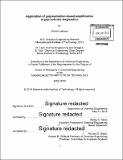| dc.contributor.advisor | Hadley D. Sikes. | en_US |
| dc.contributor.author | Lathwal, Shefali | en_US |
| dc.contributor.other | Massachusetts Institute of Technology. Department of Chemical Engineering. | en_US |
| dc.date.accessioned | 2016-09-13T19:12:43Z | |
| dc.date.available | 2016-09-13T19:12:43Z | |
| dc.date.copyright | 2016 | en_US |
| dc.date.issued | 2016 | en_US |
| dc.identifier.uri | http://hdl.handle.net/1721.1/104209 | |
| dc.description | Thesis: Ph. D., Massachusetts Institute of Technology, Department of Chemical Engineering, 2016. | en_US |
| dc.description | Cataloged from PDF version of thesis. | en_US |
| dc.description | Includes bibliographical references (pages 129-134). | en_US |
| dc.description.abstract | Diagnostic tests in resource-limited settings require technologies that are affordable and easy-to-use with minimal infrastructure. Colorimetric detection methods that provide results that are readable by eye, without reliance on specialized and expensive equipment, have great utility in these settings. Existing colorimetric methods based on enzymatic reactions and gold nanoparticles often produce results that must be read within a specified time interval to ensure their validity. In many instances, a user has to wait several minutes for the color to develop. Moreover, the result can be interpreted incorrectly because of low visual contrast. Therefore, a colorimetric detection technology that produces bright and unambiguous readout within a time interval of a few seconds to less than two minutes, and removes the burden of accurate time keeping from the user can be very beneficial in low-resource settings. Photo-initiated polymerization-based amplification (PBA) is a technology that allows detection of a surface-bound analyte through co-localization of a visible-light photoinitiator with the analyte present on the surface. In the presence of an appropriate dose of light and monomers, a subsequent free radical polymerization reaction results in formation of an interfacial hydrogel in areas where the initiator has been localized. In this thesis, we modified the eosin/tertiary amine-based PBA technology, which had previously been developed on transparent glass surfaces, for use with cellulose-based (paper) surfaces. Using Plasmodium falciparum histidine-rich protein as an example, we showed that paper-based PBA allowed high-contrast visual detection of proteins with a limit-of-detection of single digit nM concentration (~7 nM) in complex matrices such as human serum and plasma purified from blood samples through the use of a hand-operated microfluidic device. The paper-based immunoassay required only 10 [mu]L sample per test and the total time for signal amplification, from illumination to colorimetric detection, was 2-2.5 minutes per test. The method provided quantitative information regarding analyte levels when combined with cellphone-based imaging. It also allowed decoupling of the capture of analyte on the surface from the signal amplification and visualization steps. We showed that in comparison with enzymatic amplification methods and silver deposition on gold nanoparticles, PBA-based readout on paper was cheaper, easier to perceive at its limit-of-detection, and had the lowest incidence of false readouts due to timing errors. In addition to developing PBA for use in paper devices, we combined PBA with a dilution array approach for quantifying analyte levels by counting number of visible polymer spots on a biochip. We used an empirical design approach that did not depend on measurement of equilibrium and kinetic binding parameters of the antibodies used in the assay and provided a dynamic range of three orders of magnitude, 70 pM to 70 nM, for visual quantification of the analyte. We also built a portable, light-weight, and customizable LED-based device with automated timer functionality for use with PBA assays in point-of-care settings. | en_US |
| dc.description.statementofresponsibility | by Shefali Lathwal. | en_US |
| dc.format.extent | 134 pages | en_US |
| dc.language.iso | eng | en_US |
| dc.publisher | Massachusetts Institute of Technology | en_US |
| dc.rights | M.I.T. theses are protected by copyright. They may be viewed from this source for any purpose, but reproduction or distribution in any format is prohibited without written permission. See provided URL for inquiries about permission. | en_US |
| dc.rights.uri | http://dspace.mit.edu/handle/1721.1/7582 | en_US |
| dc.subject | Chemical Engineering. | en_US |
| dc.title | Application of polymerization-based amplification in point-of-care diagnostics | en_US |
| dc.type | Thesis | en_US |
| dc.description.degree | Ph. D. | en_US |
| dc.contributor.department | Massachusetts Institute of Technology. Department of Chemical Engineering | |
| dc.identifier.oclc | 958138742 | en_US |
